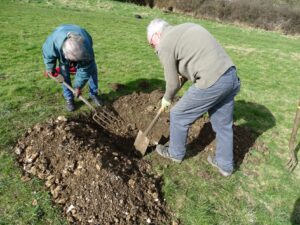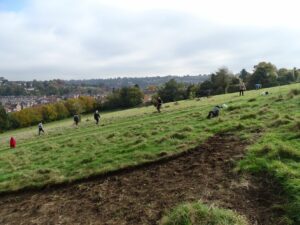

On 9th March 2022, the Chesham Environmental Group joined forces with Chesham & District Natural History Society to start the next phase of the project. The main aim was to prepare more areas and place mats for additional slow worm monitoring around the edge of the field. Then reducing the nutrients in the soil on the surface, by cutting the turf off over a 1.5metres x1.5 metres area, digging down about 500mm to a chalky subsoil, putting the turf in the bottom of the hole and then higher nutrient soil layer next and finally putting the extracted chalky layer on the top. This serves two purposes, by reducing the nutrient level of the soil at the surface creating more suitable conditions for wildflowers and the bare soil will also attract invertebrates in the short term, as bare earth will warm up more quickly than the surrounding grassy areas, so it will become a basking area for invertebrates.
